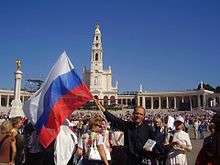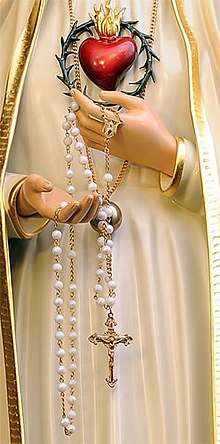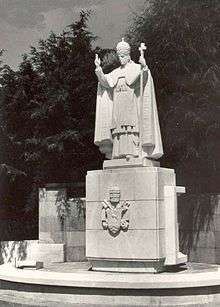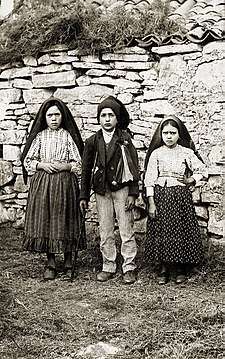Consecration of Russia


The Consecration of Russia to the Immaculate Heart of Mary by a specific act of a Pope along with all the other Catholic bishops of the world was allegedly ordered in an apparition by Our Lady of Fátima in 1917. The Carmelite nun Sister Lúcia, one of the three visionaries of the apparitions, stated that at different times the Virgin Mary had given her messages that emphasized praying the Rosary, and that she had made a number of prophecies and promises, one of these being that the consecration of Russia would usher in a period of world peace. Sister Lúcia declared in writing during the 1980s that the consecration performed by Pope John Paul II in St. Peter's Square, in the Vatican City, on March 25, 1984 had been properly accomplished and was accepted in Heaven.[1]
In addition to the Consecration of Russia, Pope Pius XII (1942), Pope John Paul II (1984), Pope Benedict XVI (2010) and Pope Francis (2013) have consecrated the world to the Immaculate Heart, with Pius XII also specifically consecrating "the peoples of Russia" in 1952, sometimes worded as "acts of entrustment".
History and background
Private revelation
The teaching of the Roman Catholic Church distinguishes between "public Revelation" and "private revelations". The term "public Revelation" finds its literary expression in the Bible and "reached its fulfilment in the life, death and resurrection of Jesus Christ".[2] In this regard, The Catechism of the Catholic Church quotes John of the Cross:
In giving us his Son, his only Word (for he possesses no other), he spoke everything to us at once in this sole Word—and he has no more to say... Any person questioning God or desiring some vision or revelation would be guilty not only of foolish behavior but also of offending him, by not fixing his eyes entirely upon Christ and by living with the desire for some other novelty.[3]
In a meeting with Cardinal Sodano, Sister Lucia pointed out that she had received the vision but not its interpretation.
Consecration of Russia

According to Sister Lúcia, the Virgin Mary requested the consecration of Russia to her Immaculate Heart on several occasions.
Lúcia lived in Spain from 1925 to 1946, during the time of the Second Spanish Republic and the Spanish Civil War. Her first mention of the Blessed Virgin's request for the consecration of Russia is in the autumn of 1929. In 1929 Lúcia Santos was a novice at the Sisters of St. Dorothy convent in Tuy, Spain. Lúcia reported that on the night of 13 June 1929, while she was praying in chapel, that she experienced a vision in which the Blessed Virgin said that it was God's will that the Pope, in union with all the Bishops of the world, consecrate Russia to her Immaculate Heart. Sister Lúcia reported this to her confessor who asked her to write it down.
In two letters she sent in May 1930 to Fr. Gonçalves, her confessor, Lúcia linked the consecration of Russia with the Devotion of the Five First Saturdays, which she had first discussed in context of the apparitions she had purportedly experienced previously as a postulant at Pontevedra in 1925. (The Church has issued no decision regarding the reported visions at either Pontevedra or Tuy.[4]
In August 1941 Sister Lúcia wrote her third memoir in which she described the apparition of 13 July 1917. She said that the Virgin told them:
"God wishes to establish in the world devotion to my Immaculate Heart. If what I say to you is done, many souls will be saved and there will be peace. The [First World] war is going to end; if people do not cease offending God, a worse one will break out during the pontificate of Pius XI. When you see a night illumined by an unknown light, know that this is the great sign given you by God that He is about to punish the world for its crimes, by means of war, famine, and persecutions of the Church and of the Holy Father. To prevent this, I shall come to ask for the consecration of Russia to my Immaculate Heart. If my requests are heeded, Russia will be converted, and there will be peace. If not, she will spread her errors throughout the world, causing wars and persecutions of the Church. The good will be martyred, the Holy Father will have much to suffer, various nations will be annihilated. In the end, my Immaculate Heart will triumph. The Holy Father will consecrate Russia to me, and she will be converted, and a period of peace will be granted to the world."
Consecration in the Roman Catholic Church

Two popes consecrated Russia within the Roman Catholic Church based on the messages of Fátima and Tuy. One was Pope Pius XII, who was appointed Archbishop in the Sistine Chapel on May 13, 1917, the same day the Fátima apparitions were reported. The other was Pope John Paul II, who was shot in Rome on May 13, 1981 and later credited Our Lady of Fátima with his recovery, saying that it was "in mysterious coincidence with the anniversary of the first apparition".[5][6]
- Pope Pius XII in October 1942 performed the Consecration to the Immaculate Heart of Mary for the entire world, and in July 1952 he specifically consecrated the Peoples of Russia to the Immaculate Heart of Mary by his apostolic letter Sacro Vergente Anno. Pius XII stated:[7][8]
"Just as a few years ago We consecrated the entire human race to the Immaculate Heart of the Virgin Mary, Mother of God, so today We consecrate and in a most special manner We entrust all the peoples of Russia to this Immaculate Heart…"
- Pope John Paul II on 25 March 1984 consecrated Russia and the world in a public ceremony at St. Peter's in Rome; the consecration was in the form of a 'whole-world consecration' that included the participation of the Catholic bishops throughout the world. Cardinal Bertone said to the press many times that the message of Fátima was finished. Cardinal Bertone reported that Lúcia dos Santos had said that the consecration requested by the Virgin Mary had been fulfilled and accepted in Heaven, and that everyone should live out the consecration personally by faithfully wearing the brown scapular.[9]
The entrance to the Sanctuary of Our Lady of Fátima, to the south of the rectory, is a segment of the Berlin Wall intended to emphasize the belief that the Rosary prayers influenced the fall of the Berlin Wall related to the Consecration of Russia based on the Our Lady of Fátima messages.[10]
Russian Orthodox objections
Orthodox Christians often see the Fátima consecration in the light of the history of Latin-Orthodox religious conflict going back a thousand years. They tend to interpret the Fátima consecration as an encroachment by Latin Christianity on Orthodox territory while Catholics tend to see the matter as followers of Christ vs. atheistic Communism. Orthodox Christians and especially members of the Russian Orthodox Church object to the concept of the Consecration of Russia for two reasons: (1) Russia was already Christian at the time of the alleged Fátima apparitions and had a long history of devotion to the Theotokos, and (2) the concept contains what appears to be an implicit proselytism of Russian Orthodox Christians to the Catholic Faith. Orthodox apologists thus tend to understand the phrase "Russia will be converted" as implying conversion from Orthodox Christianity to Roman Catholicism and acceptance of papal infallibility and universal supreme jurisdiction. Catholics respond that the apparitions at Fátima took place after the March 1917 revolution that deposed Tsar Nicholas and the April 16 [N.S.] return to Russia of Lenin.[11] Russia was thus already in the throes of revolution and facing a renewed threat from a Bolshevism particularly hostile to all organized religion when prayers for Russia were first requested in May. The final October miracle occurred just weeks before the Communist Revolution. They argue that this timing suggests that the consecration refers to the threat that Russia faced from atheistic Communism. In 1946 during a gathering of youth at Fátima, Sister Lucia was asked by a young Russian girl (Natacha Derfelden) how the conversion of Russia would come about. However, Sister Lucia stated that the conversion of Russia would come through the Orthodox Church and "the Oriental rite"[12][13], seemingly meaning the conversion implied reconciliation and reunion between the Russian Orthodox Church and the Roman Catholic Church. Yet, another possibility is that it means a conversion of the heart, which conforms to the theological commentary written by Joseph Cardinal Ratzinger (later Pope Benedict XVI) on the Fátima secret.[14]
However, the conception of Theotokos Derzhavnaya Orthodox icon points out that Virgin Mary is considered actual Tsarina of Russia by the religious appeal of Nicholas II; thus Consecration of Russia may refer to a return of Russian monarchy.[15] The icon was brought to Fátima in 2003 and 2014, together with another significant Theotokos of Port Arthur icon.[16]
See also
Sources
- Sister Lúcia, 1995, Fatima in Lucia's Own Words, The Ravengate Press, ISBN 0-911218-10-6
- Thomas Petrisko, 1998, Fátima Prophecies, St. Andrews Press, ISBN 978-1-891903-30-4
- Carmel of Coimbra, 2015, A Pathway Under the Gaze of Mary: Biography of Sister Maria Lucia of Jesus and the Immaculate Heart, World Apostolate of Fatima, ISBN 978-0-578158-63-1
- Fátima Novena [17]
References
- ↑ Vatican Statement, in official document, ¨Sister Lucia personally confirmed that this solemn and universal act of consecration corresponded to what Our Lady wished (“Sim, està feita, tal como Nossa Senhora a pediu, desde o dia 25 de Março de 1984”: “Yes it has been done just as Our Lady asked, on 25 March 1984”: Letter of 8 November 1989). Hence any further discussion or request is without basis.¨ Vatican Official Web Page,http://www.vatican.va/roman_curia/congregations/cfaith/documents/rc_con_cfaith_doc_20000626_message-fatima_en.html
- ↑ "The Message of Fatima". Vatican.va. Retrieved 2016-08-11.
- ↑ "Catechism of the Catholic Church". Usccb.org. Retrieved 2016-08-11.
- ↑ "Archived copy". Archived from the original on 2012-12-09. Retrieved 2012-12-25.
- ↑ "Pope Pius XII and Fatima". Ewtn.com. Retrieved 2016-08-11.
- ↑ Garry Wills, Why I am a Catholic, Houghton Miflin Publishers, p. 246
- ↑ Acta Apostolicae Sedis 44, 1952, page 505
- ↑ "Sacro vergente anno. - Consacrazione della Russia al Cuore immacolato di Maria (7 luglio 1952) | PIO XII". Vatican.va. Retrieved 2016-08-11.
- ↑ Mark Miravalle, 1993, Introduction to Mary, p. 171.
- ↑ Regis St. Louis and Robert Landon, 2007, Portugal, Lonely Planet Press, p. 290,
- ↑ "The SEALED TRAIN" by Michael Pearson, New York:Putnam [1975] ISBN 0399112626
- ↑ Quoted in "Russia Will be Converted" by John Haffert, President of the Blue Army, 1956, p. 204
- ↑ "Russia Will Be Converted" (PDF). Johnhaffert.org. Retrieved 2016-08-11.
- ↑ "The Message of Fatima". Vatican.va. Retrieved 2016-08-11.
- ↑ "БУДЕТ ЦАРЬ! О РОССИИ ВЕРУЮЩЕЙ И БОРИМОЙ. Старец Рафаил (Берестов) » Москва - Третий Рим". 3rm.info. Retrieved 2016-08-11.
- ↑ Archived June 25, 2014, at the Wayback Machine.
- ↑ Geo. M. Haney Jr. "Prayerbook, Nine Day Novenas, Our Lady of Fatima". Prayerbook.com. Retrieved 2016-08-11.
External links
- rev. L. Kondor (SVD) (Jul 31, 2017). Fátima in Sister Lúcia’s own words (pdf). Translated by Dominican Nuns of Perpetual Rosary. Fatima. Archived (PDF) from the original on Oct 6, 2014. Retrieved Sep 4, 2018. (free e-book)
- "Text of the Papal Consecration to the Blessed Virgin Mary: Pope Pius XII". ewtn.com. Archived (PDF) from the original on Mar 11, 2017.
- Portugal and Fátima: a concise explanation (in Portuguese and English). Archived from the original on Jun 30, 2017.
